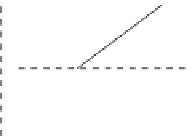Environmental Engineering Reference
In-Depth Information
7.2.3 Compton Scattering
As our final example, we shall take a close look at the theory behind an experi-
ment performed in 1923 by Arthur Compton which provided very direct evidence
that photons exist as massless particles behaving according to the ideas of Special
Relativity. Compton shone short wavelength light (X-rays) onto a target and looked
at the angular distribution of the scattered radiation. He was particularly interested
in measuring the difference in wavelength between the incident and scattered light
as a function of scattering angle. It is one of the triumphs of modern physics that
Compton's results can be explained in terms of the simple process illustrated in
Figure 7.5. The incoming light constitutes a source of photons and the shift in
wavelength detected by Compton arose as a direct result of scattering individual
photons in the source elastically off individual atomic electrons in the target.
E'
,
p'
g
q
g
f
e
E
e
E
e
,
p
e
Before
After
Figure 7.5
Compton scattering.
Referring to Figure 7.5, we shall aim to compute the energy of the scattered
photon in terms of the energy of the incoming photon and the photon's scattering
angle
θ
. The photon energies and the scattering angle were measured in Comp-
ton's experiment, whereas the energy and scattering angle of the recoiling electron
were not, so we must eliminate them from our theoretical analysis. Applying the
conservation of momentum we can write
E
c
=
E
c
cos
θ
+
p
e
cos
φ
(7.38)
E
c
and
sin
θ
=
p
e
sin
φ.
(7.39)
=
We have used
E
cp
to write the photon momenta in terms of the incoming and
outgoing photon energies. The conservation of energy tells us that
m
e
c
2
E
+
E
+
=
E
e
(7.40)
and we have been careful not to forget that the initial electron, although it is
assumed to be at rest
8
, still has its rest mass energy. Given these equations our
challenge is to express
E
in terms of
E
and
θ
, i.e. we must eliminate all dependence
upon the scattered electron momentum. It is quite easy to go around in circles in
8
We do not need to worry about the fact that the electron is not actually at rest since its kinetic energy
when bound in an atom (
∼
1 eV) is much less than its rest mass (
∼
10
6
eV).












